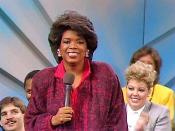Defining the cultural forum, Newcomb and Hirsch explain that television serves as a medium whereby "contemporary cultures examine themselves through their arts." Examining current television programming, an argument can be made that the medium has and continues to benefit society in providing responsible and informative information. In addition, television programs have provided an effective vehicle to address important social issues effecting various sectors of society including women, minorities, and children.
In today's television programming, several programming formats and themes are available to viewers. Traditional genres such as news, soap operas, situation comedies, and dramas have been supplemented by an array of talk shows, cable programming, made for television movies, sports programming, and a host of other subjects. The primary objective of each program is to provide entertainment or information.
The structure of news programming has advanced significantly over time. Satellite technology has allowed news coverage to reach virtually everywhere in the world in real time.
This has brought extraordinary events and information direct to viewers homes from the area of the planet news breaks. CNN's coverage of the Gulf War provides an example of how the medium of television can provide consumers with immediate and powerful images and stories occurring in today's global society. In this way, consumers are enriched by utilizing the medium as a powerful information gathering device.
Information provided by television news is often the most current available, allowing consumers to maintain perspective of where different aspects of society, of importance to them, are heading. For example, when John Salvi assaulted two abortion clinics, television news organizations initially brought the story to viewer households on a local and national level. This provided an outlet for viewers to gain information on the actual event. If the event affected consumers in some way, the televised reports may provide a...


